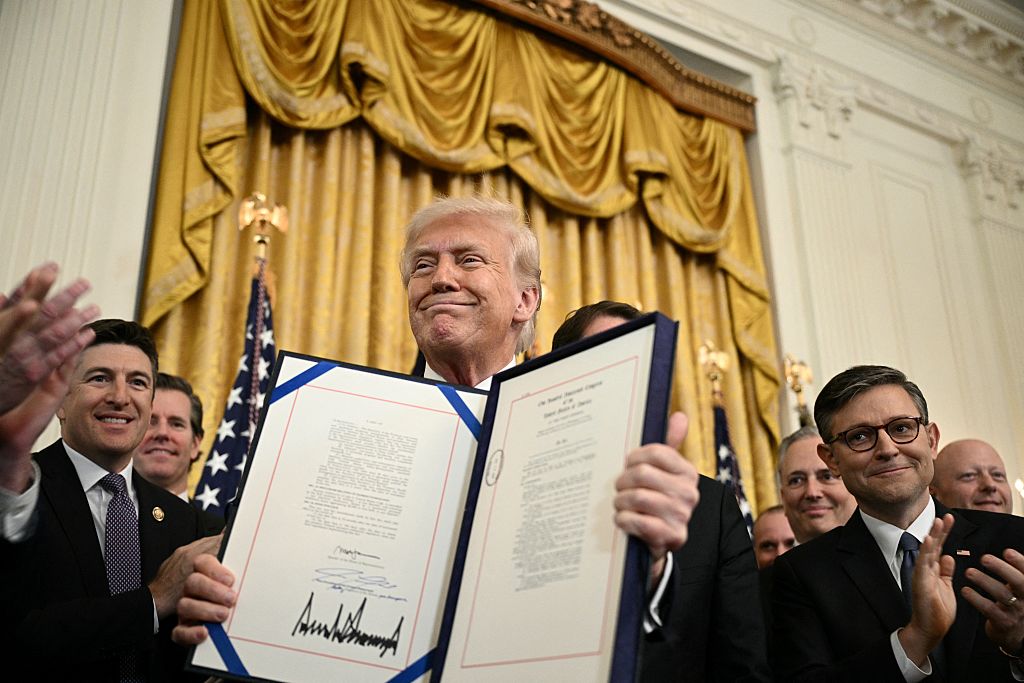Investors should cheer the coming nuclear summer
The US and UK have agreed a groundbreaking deal on nuclear power, and the sector is seeing a surge in interest from around the world. Matthew Partridge looks at how you can profit


There may be few things that UK prime minister Keir Starmer and US president Donald Trump agree upon, but one of them is the benefits of nuclear power. The centrepiece of Trump’s recent state visit to the UK was a series of agreements to “accelerate the build-out of new nuclear-power stations and support billions in private investment into the technology”, as Jean-Hugues de Lamaze, manager of Ecofin Global Utilities and Infrastructure Trust, puts it. With the rise of AI leading to what Tancrede Fulop, a senior equity analyst for Morningstar, calls “a growth in energy consumption not seen for decades”, they are not the only enthusiasts.
The debate over energy policy has changed dramatically in recent years. “For the last two decades, we’ve been talking about transitioning from a certain set of fossil fuels to cleaner technologies,” says Mobeen Tahir, director of research at WisdomTree. But in the past few years we’ve come to realise that at the same time we also need to “increase the amount of energy we produce to deal with the demands of the digital economy”. The problem is that these two goals seem contradictory. Renewable energy may be environmentally friendly, but it is not as reliable – wind power and solar energy only generate electricity when the wind is blowing or the sun is shining.
Traditional fossil fuels generate power as and when needed, but they are polluting and causing climate change. The solution is nuclear power, which provides the best of both worlds – “addressing the intermittency issues of renewables without compromising on the environmental credentials”, says Tahir. He argues that you can even make the case that nuclear power is more environmentally friendly than most renewables as a nuclear-power plant produces more energy per square foot, which means that you also use much less land.
MoneyWeek
Subscribe to MoneyWeek today and get your first six magazine issues absolutely FREE

Sign up to Money Morning
Don't miss the latest investment and personal finances news, market analysis, plus money-saving tips with our free twice-daily newsletter
Don't miss the latest investment and personal finances news, market analysis, plus money-saving tips with our free twice-daily newsletter
Nuclear power is also by some measures more economic than most fossil fuels. The fixed costs of building a nuclear reactor are substantial, says Greg Eckel, portfolio manager of Canadian General Investments, but once the reactor is up and going, “it is probably the cheapest form of energy on an ongoing basis”. Eckel reckons that the most likely scenario for the future of energy is now one where nuclear does the bulk of the work, “allowing other renewable sources of energy to just fill in the gaps”.
Nuclear power and Big Tech’s thirst for energy
The need for a clean, stable source of power is particularly pressing in the technology sector, where the AI revolution has led to an explosion in the number of power-hungry data centres, says Tyler Rosenlicht, portfolio manager for global listed infrastructure at Cohen & Steers. And as well as requiring a huge amount of additional energy, the centres also require a high degree of reliability. After all, if you are a technology executive “the last thing you would want would be for your data centres to shut down suddenly because the power supply either cuts out, or starts fluctuating”.
Indeed, as Rosenlicht points out, the tech companies are so eager for the sort of “tried and tested” energy that nuclear power can provide that they aren’t waiting for new plants to be built, but doing deals directly with nuclear-power companies. Sometimes the aim is to prolong the life of power plants due to expire. In other cases, tech companies have underwritten the cost of building new reactors, either through upfront payments or by agreeing long-term contracts. Both of these are important as the need to make a large capital investment for an uncertain future has always been one of the barriers holding back the spread of the technology.
Pretty much all the major companies, such as Amazon, Apple and Meta, have made at least some long-term agreements with nuclear power, with Amazon and Alphabet (Google’s parent company) striking several deals last year. This isn’t a one-way street either – tech company Palantir has said that it plans to use its expertise to develop AI software aimed at accelerating the development of nuclear reactors, “which is exactly the sort of support that we need to make the whole industry more efficient and exciting”.
Of all the deals between tech companies and nuclear utilities, the most symbolic is Microsoft’s with Constellation Energy to reopen Three Mile Island, which shut in 2019. It could be back up and running as soon as 2027 and provide energy for Microsoft’s data centres for the next two decades. It’s symbolic because Three Mile Island was the site of a radiation leak in 1979, just 12 days after the release of The China Syndrome, a film about a fictional nuclear meltdown. That “created a lot of negativity about nuclear power in the mind of the public”, as Tahir says. Three Mile Island’s reopening may be a turning point.
Changing attitudes to nuclear power
The impact of Three Mile Island (as in the case of Fukushima later) was widely exaggerated and features more strongly in the public mind than nuclear power’s stellar safety record. “The facts on the ground have always been on the side of the industry, but these facts have taken a long time to be accepted by the wider public,” says Marco Visscher, author of The Power of Nuclear: The Rise, Fall and Return of Our Mightiest Energy Source. Now, however, he senses that the war in Ukraine and the failure of climate policy has forced the public and policymakers to be more pragmatic.
Visscher points to opinion surveys showing that “across the world, more people are in favour of nuclear power than oppose it”. In the United States, for example, polls show that 57% of people want more nuclear power, up from 43% just three years ago. Similarly, support for nuclear power in the Netherlands has gone up by half in the space of a few years; 85% of those in Belgium now oppose the planned decision to phase out nuclear power and want to keep it. Support for nuclear power is also high in the UK, with three people supporting nuclear power for every one who opposes it.
Government policy is starting to follow suit. As well as the recent agreement between the US and UK, several European countries, which “had historically been unfavourable to nuclear technology, are now thinking about reversing this opposition”, says de Lamaze. He notes that Italy’s Council of Ministers approved a draft law in early 2025 to reintroduce nuclear power nearly 40 years after it was effectively banned following a nationwide vote in 1987.
Joachim Klement, head of Strategy at Panmure Liberum, notes that many countries around the world are removing restrictions on nuclear power. This includes Japan, which is now starting to reopen the plants mothballed following the Fukushima disaster. Germany may be about to follow suit. Chancellor Friedrich Merz has agreed to allow nuclear power to be treated as a renewable sources of energy on an EU level and is considering reversing Angela Merkel’s infamous shutdown of Germany’s nuclear sector.
Many Asian countries are also thinking about beginning their own civil nuclear programmes from scratch, says Klement. Indonesia is one example, as is Malaysia, which is “hoping that nuclear power can help it fulfil its dreams of becoming Asia’s data-centre hub”, says Klement. Malaysia has already agreed contracts with international companies to start developing reactors. South Korea and India, which are already big investors in nuclear power, are also ramping up their efforts to increase production.
The rise of small modular reactors
There is a wave of optimism regarding the emerging technology of small modular reactors (SMRs). As Klement explains, their small size – they have a typical output of around 300 MW-400 MW, compared with 3GW for a large reactor such as Sizewell C – means they obviously take up much less physical space. This, in turn, means “you can locate them right next to an industrial park or major data centre” and also use the heat they create for other industrial purposes. They can also be up and running much sooner than a power plant, which can take as long as a decade to build, says Fulop.
The vision of a “tennis-court-sized nuclear reactor that is hooked up to a data centre and feeding it clean, stable, predictable energy all day every day” has the potential to transform the nuclear industry, says Rosenlicht. He emphasises that, although this might sound like science-fiction, there’s no question that the underlying technology is “viable”. Indeed, a form of SMR has been in use for decades to power nuclear submarines.
With the technology viable, the key remaining question is cost – and SMRs are still “extremely expensive”, says Rosenlicht. Still, the recent surge in SMR-related investment may help solve this problem by starting to make them more cost-effective. Rosenlicht expects SMRs to become competitive with conventional reactors sometime between 2030 and 2035. This may seem to be a bit longer than you might expect given some of the rhetoric around the technology, but “it’s not that long when you consider that the increased demand for from AI and other technologies is a long-term trend that is not going away”.
Indeed, in the very long run, small modular reactors could end up being much cheaper than conventional reactors. Their small size means they could be built into a factory much like a jet engine is built into a aeroplane rather than having to be assembled onsite, says Klement. He notes that past experience in other industries, such as aerospace, suggests that “while the first ones to be produced will be extremely expensive, the cost to produce each additional SMR will quickly plummet as the companies making them learn from their mistakes”. Once SMRs are up and running, they could end up producing electricity for a third or less of the cost of larger reactors.
Potential winners from the nuclear summer
So, who are going to be the big winners from this nuclear summer? Perhaps the most obvious group of companies to benefit will be those that mine the uranium that is needed to power these nuclear plants. John Ciampaglia, CEO of Sprott Asset Management and partner with HANetf for the Sprott Uranium Miners UCITS exchange-traded fund, notes that the current fleet of nuclear-power plants require a total of around 180 million pounds of uranium. Current production of uranium is only 150 million pounds. Even now, we are in a supply deficit as the increase in the uranium supply has been slower than expected.
Ciampaglia thinks the current gap between demand and supply could increase even further. Worldwide demand for uranium is expected almost to double to between 300 million and 350 million pounds over the next 15 years as countries “expand capacity through new builds, life extensions of shuttered plants and restarts of shuttered facilities”. There are signs that investors are starting to allocate more money in an attempt to close the gap, but the mismatch means that uranium miners and the companies developing new mines are “well positioned” to get a good price for the uranium that they extract for some time to come.
The miners aren’t the only companies who stand to do well from the revival of interest in nuclear power. Tahir reckons that all parts of what he calls the “nuclear value chain” will benefit. This includes the “midstream companies, which do things such as converting raw uranium into something that can be used to carry out the nuclear reactions that produce energy”. Other midstream tasks include storage, building nuclear reactor, as well as providing services such as maintenance, safety checks and even the decommissioning of plants that have reached the end of their useful life.
The aspect of the nuclear supply chain that investors are most interested in, however, is the companies that Tahir calls the “innovators” – the firms that are developing the new technologies that will transform the industry. Many of them are not generating revenue yet, but Tahir thinks they are worth investing in as they “have a huge amount of potential growth ahead of them”. As well as the companies involved in small modular reactors, there are other interesting technologies, such as attempts to recycle the uranium used in the process (at the moment, only 5% of the nuclear fuel actually gets used in energy generation).
The best plays in the nuclear sector
One way to invest in the nuclear sector is through an exchange-traded fund such as VanEck Uranium and Nuclear Technologies ETF (LSE: NUCL). This holds 25 companies, mostly from the US, Canada and Japan, including uranium miners, companies designing nuclear reactors (both large-scale and small modular reactors) and utilities. Its largest holdings include firms such as exploration company NexGen Energy and small modular reactor developer NuScale Power, as well as companies such as Cameco and Oklo (see below). The fund has an average price/earnings ratio of 26 and a total expense ratio (TER) of 0.56%.
As the name suggests, the Sprott Uranium Miners ETF (LSE: URNM) focuses on 35 companies that mine uranium. Its TER is 0.85%.
Cameco (Toronto: CCO) is the second-largest uranium miner in the world. Greg Eckel of Canadian General Investments is particularly impressed that Cameco “has learned to anticipate supply and demand and adjust production in light of how the market is evolving”. He also likes the fact that the company has broadened into other parts of the supply chain, owning nearly half of Westinghouse, for example, “which does the full cycle of designing, building, maintaining and decommissioning nuclear reactors”. Cameco trades at an aggressive 55 times 2026 earnings, but this is justified by the fact that revenue has more than doubled since 2021.
A purer play on the development of advanced nuclear technology is Oklo (NYSE: OKLO). As stated in the main story above, WisdomTree’s Mobeen Tahir likes Oklo, as it is one of the leading companies involved in the development of small modular reactors. Its first is planned for 2027. It is also finding ways to recycle nuclear waste. Oklo is a slightly riskier investment as it is currently losing money, but there is plenty of cash on hand to tide it over until profitability is reached in the next couple of years.
Another leader in the development of small modular reactors is Rolls-Royce Holdings (LSE: RR). The company is currently best known for its engines and defence products. The UK government (among others) has selected Rolls-Royce as one of its preferred partners to develop small modular nuclear reactors over the next decade. It trades at 36 times 2026 earnings, but this is more than justified by its rapid turnaround in recent years and its growth potential.
Few utilities specialise solely in nuclear power, as Morningstar’s Tancrede Fulop points out. Korea Electric Power Corp (Seoul: 052690), for example, uses gas and coal to generate power and is known across the world for its expertise, but it also uses nuclear power to generate electricity, and builds and designs nuclear-power plants around the world. As well as projects in the US, it is behind plans to build the first new reactor in Japan since the Fukushima disaster. Trading at less than four times current earnings, it is available to Western investors via depositary receipts traded on the New York Stock Exchange (NYSE: KEP).
Another utility that Fulop likes, and which is located a little closer to home, is Centrica (LSE: CNA). At the moment, it makes around 20% of its operating profit from nuclear power, including a 15% stake in the Sizewell C nuclear power station that is being built in Suffolk. This should increase as it has agreed to invest in 12 new nuclear-power plants that X-Energy is planning to build in Hartlepool. Centrica trades at 11.4 times 2026 earnings, with a dividend yield of 3.6%.
This article was first published in MoneyWeek's magazine. Enjoy exclusive early access to news, opinion and analysis from our team of financial experts with a MoneyWeek subscription.
Get the latest financial news, insights and expert analysis from our award-winning MoneyWeek team, to help you understand what really matters when it comes to your finances.

-
 The investing mistakes not to make: MoneyWeek Talks
The investing mistakes not to make: MoneyWeek TalksPodcast MoneyWeek's digital editor speaks to Andrew Craig, founder of Plain English Finance, about why passive investing isn't always the only option for good investors
-
 Household savings ratio drops – are you setting enough aside for 2026?
Household savings ratio drops – are you setting enough aside for 2026?High inflation has pushed the savings ratio down again and the figure could dip further next year
-
 Stock markets have a mountain to climb: opt for resilience, growth and value
Stock markets have a mountain to climb: opt for resilience, growth and valueOpinion Julian Wheeler, partner and US equity specialist, Shard Capital, highlights three US stocks where he would put his money
-
 The steady rise of stablecoins
The steady rise of stablecoinsInnovations in cryptocurrency have created stablecoins, a new form of money. Trump is an enthusiastic supporter, but its benefits are not yet clear
-
 SRT Marine Systems: A leader in marine technology
SRT Marine Systems: A leader in marine technologySRT Marine Systems is thriving and has a bulging order book, says Dr Michael Tubbs
-
 Goodwin: A superlative British manufacturer to buy now
Goodwin: A superlative British manufacturer to buy nowVeteran engineering group Goodwin has created a new profit engine. But following its tremendous run, can investors still afford the shares?
-
 A change in leadership: Is US stock market exceptionalism over?
A change in leadership: Is US stock market exceptionalism over?US stocks trailed the rest of the world in 2025. Is this a sign that a long-overdue shift is underway?
-
 A reckoning is coming for unnecessary investment trusts
A reckoning is coming for unnecessary investment trustsInvestment trusts that don’t use their structural advantages will find it increasingly hard to survive, says Rupert Hargreaves
-
 Modern Monetary Theory and the return of magical thinking
Modern Monetary Theory and the return of magical thinkingThe Modern Monetary Theory is back in fashion again. How worried should we be?
-
 Metals and AI power emerging markets
Metals and AI power emerging marketsThis year’s big emerging market winners have tended to offer exposure to one of 2025’s two winning trends – AI-focused tech and the global metals rally